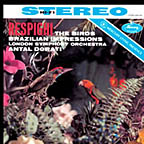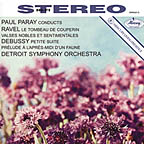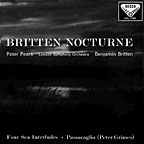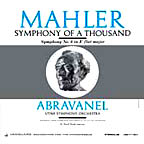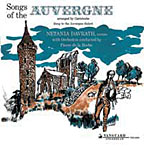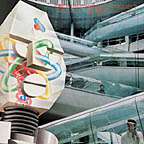|
You are reading the older HTML site
Positive Feedback ISSUE
14
Hi-Res reviews featuring our friends from Audiophile Audition Let's take a break from hi-res digital discs this time and turn to another hi-res format in our July-August issue - good ol' vinyl. John Sunier Six Audiophile Vinyl Reissues Evaluated
The Mercury Reissues: Which Presence is More Alive? So, recently I traveled with my vinyl junkie friend Dan Oppermann from San Francisco to Davis, Ca. to the house of John Uyeyama, owner of the some awesome sound equipment (see the end of this article for details). I brought with me FR-1 copies of SR 90153 (Respighi's The Birds and Brazilian Impressions—London Symphony/Dorati) and SR 90213 (Ravel's Le Tombeau de Couperin, Valse Nobles et Sentimentales, Debussy's Petite Suite and Prelude to the Afternoon of a Faun – Detroit Symphony Orchestra/Paray). All three of us compared the recent Speakers Corner's vinyl reissues to the original vinyl first issues with the Wilma Cozart produced CDs. The result was revelatory, yet predictable. The FR-1 original record of Ravel's Petite Suite was spectacular: outstanding transparency and clarity; great low end dynamics, percussion that jumps out at you; and texture that revealed every nuance that the score. There is a vibrancy and aliveness to this record that makes it one of the most desirable Mercs. In comparison, the Speaker's Corner reissue was only a good reproduction of the original. The clarity of the original was lost in a haze; the strings lost their bite; transparency diminished; dynamics significantly reduced. The big revelation was how well the 1992 CD reissue captured the presence, clarity and excitement of the original vinyl pressing. In the original pressing, the bite of the strings was slightly smudged (inner groove distortion), while the CD reissue rendered sweetness and clarity. The imaging and staging of the instruments was stunning. The CD lost a slight bit of transparency but projected a clarity that was simply awesome. If you're a vinyl collector and have equipment that can show off the FR-1's pressing's greatness, go out and find yourself one. On the other hand, the CD is just as good as the original pressing in almost every way. Ms. Cozart waited until the technology could adequately represent the sonic magnificence of her creations and knew how to get all of it on the CD. With Respighi's The Birds, the LP reissue's bass projection is fat; the percussion's clarity is a bit muffled but the basic transparency is there, albeit with less impact. The FR-1 original is again one of the great examples of early sonic brilliance: it's cut hotter than the reissue and with the clarity, transparency, dynamics that simply can rattle your bones and astound the mind. You can hear the friction of the bow of the violin on the strings and imagine the rosin released; there's detail on the double basses that will resonate with the organs on your body. I got up out of my chair and imagined walking into the orchestra. Each section of the orchestra was clear in terms of scaling and staging. If you find a FR-1 copy of this recording (SR 90153), buy it immediately. In comparison, the CD reissue is far superior to the vinyl reissue in terms of clarity, transparency, and imaging. It's a bit edgy in climaxes, but still a superb reproduction of the master tape (circa 1990).
Obviously, these Speaker's Corner black disc reissues were a
disappointment, especially since their Decca vinyl reissues were so
outstanding. Why? No matter how careful the storage of the original
master tapes, (and how fanciful the story around their discovery in
Europe) one must question the effect of 40 years of time on their
condition. For myopic vinyl fanatics, the reissues are worth $30 as
decent reproductions of the original. But don't let the hype
surrounding these reissues deceive you: the original and the CD
reissue are better reproductions of the glory of the master tapes.
The FR-1 vinyl original is the equivalent of having an original
Monet in your living room, at a drastically lower cost. (There's a
second chance at equalling or surpassing the originals coming up—the new SACD reissues of the Mercuries which we will be reporting on
soon...Ed.) Robert Moon
BENJAMIN BRITTEN: Nocturne for tenor, seven obligato instruments and strings - Peter Pears, tenor/members London Symphony Orch./Britten; Four Sea Interludes & Passacaglia from "Peter Grimes" - London Sym. Orch./Britten - Decca/Speakers Corner SXL LP Reissue 2189 Being more of an instrumental person, Britten's vocal music is not among my favorites, but this song cycle is one of his finest. The poems are drawn from many different sources and all deal with nighttime, sleep and death. Though the work begins and ends in C Major it is not by all means bright and sunny melodically. The performers on this 1960 recording couldn't be more illustrious—Britten's longtime partner Pears as the tenor, master clarinetist Gervase de Peyer, hornist Barry Tuckwell and harpist Osian Ellis among them. The real audiophile instrumental treat is the composer's rousing interpretation of the interludes taken directly from the complete recording is his opera Peter Grimes. There are even some brief vocal sections left in to demonstrate how the instrumental portions meld into the vocal arias. The contrasting moods of the opera (and of Grimes' character himself) are depicted in the interludes, building up to the violent final Storm. This work has long been my favorite Britten work, and while his version doesn't quite match the sturm und drang of a later Andre Previn version on EMI vinyl, I find it musically authentic and satisfying right up until the somewhat subdued climax of the storm. Surfaces are completely quiet and all the artwork and notes of the original Decca/London release are preserved. John Sunier
MAHLER: Symphony of a Thousand - No. 8 in E Flat Major - Soloists/Combined University of Utah Choruses/Utah Symphony Orchestra/Maurice Abravanel - Vanguard/Classic Records 2 LPs, 200 gram Quiex SV-P Super Vinyl VSD 71120/1 We reviewed the HDAD/DVD-A release of this massive work last month in AUDIOPHILE AUDITION. See that review for a precis of this very unusual musical creation. This historic Marc Aubort-engineered recording is part of the same series of Utah Symphony recordings made by Vanguard on four-channel tape back in the late 60s and early 70s, from which the Berlioz Requiem above was sourced. Classic has chosen to reissue this work in stereo only, but in three different formats: The two-sided HDAD - One side is a 96K DVD-V playable on any DVD video player (although some will downsample it to 48K automatically). The other side is 192K stereo DVD-Audio, playable only on DVD-A players. Plus this 2-LPvinyl reissue. (I would have preferred to hear the work in its original multichannel form, but forced myself to analyze the two-channel versions since that's all there is at this point.) I found the 192K format to have a more extended high frequency spectrum. The bells in the work sounded more bell-like and also more metallic. Going to the 96K side of the disc brought up some IM distortion in the loud choral passages—and there are plenty of them. They weren't as noticeable in the 192K version. Otherwise the two were quite similar. The vinyl version showed it to have more "air" than the 192K disc, more surround effect than the HDAD when fed thru Pro Logic II, and during brief pauses in the massive sounds, the reverberation had a longer tail than on either of the digital formats. Vinyl gear included a SOTA vacuum Star turntable, SME-V arm, Spirit Transfiguration MC cartridge, Grado phono preamp, Jena Labs cables, and many support/mounting tweaks to the turntable. Time didn't permit cleaning the LPs first on my VPI 16.5 cleaner, which usually results in even better playback sonics. John Sunier
Songs of the Auvergne Vol. 1 & 2 - Arr. by Canteloube - Natania Davrath, soprano, with Orchestra conducted by Pierre de la Roche - Vanguard Stereolab/Classic Records, 200 gram Quiex SV-P Super Vinyl VSD-2090 - 2 LPs Also released in three different formats simultaneously, the HDAD version of this is reviewed in our Hi-Res section in this issue of AudAud. It's great to have the original two discs with all the original liner notes and lovely artwork on both covers—front and back. Also, the vinyl pulled ahead of both of the digital realizations with more "air" and ambient information than the digital. When fed thru Pro Logic II it produced an excellent surround field, and the quiet disc surfaces of the discs were not annoying in the least (even though I didn't first use my record-cleaning machine) as can occur with some vinyl when using matrix surround recovery.
The Alan Parsons Project - I Robot - Arista/Classic Records, 200 gram Quiex SV-P Super Vinyl 7002 LP Also reviewed in our AudAud Hi-Res section this time. The comparison of the 192K DVD-A and this vinyl reissue were very close, but again the vinyl had a bit more soundstage spread horizontally and a bit more air around the sounds (in spite of many of them being electronic). It's also nice to have the full 12-inch-square version of the cover art and photography. In some ways releasing I Robot on vinyl seems as counterproductive—considering the heavy use of electronics—as the Italian vinyl reissue of the all-electronic soundtrack to Forbidden Planet, which I reviewed here a few issues ago. At least the music here is better, and you only have to invest in one disc rather than two as with the Mahler and Auvergne vinyl sets. John Sunier Reviews reprinted with permission from Audiophile Audition
|


